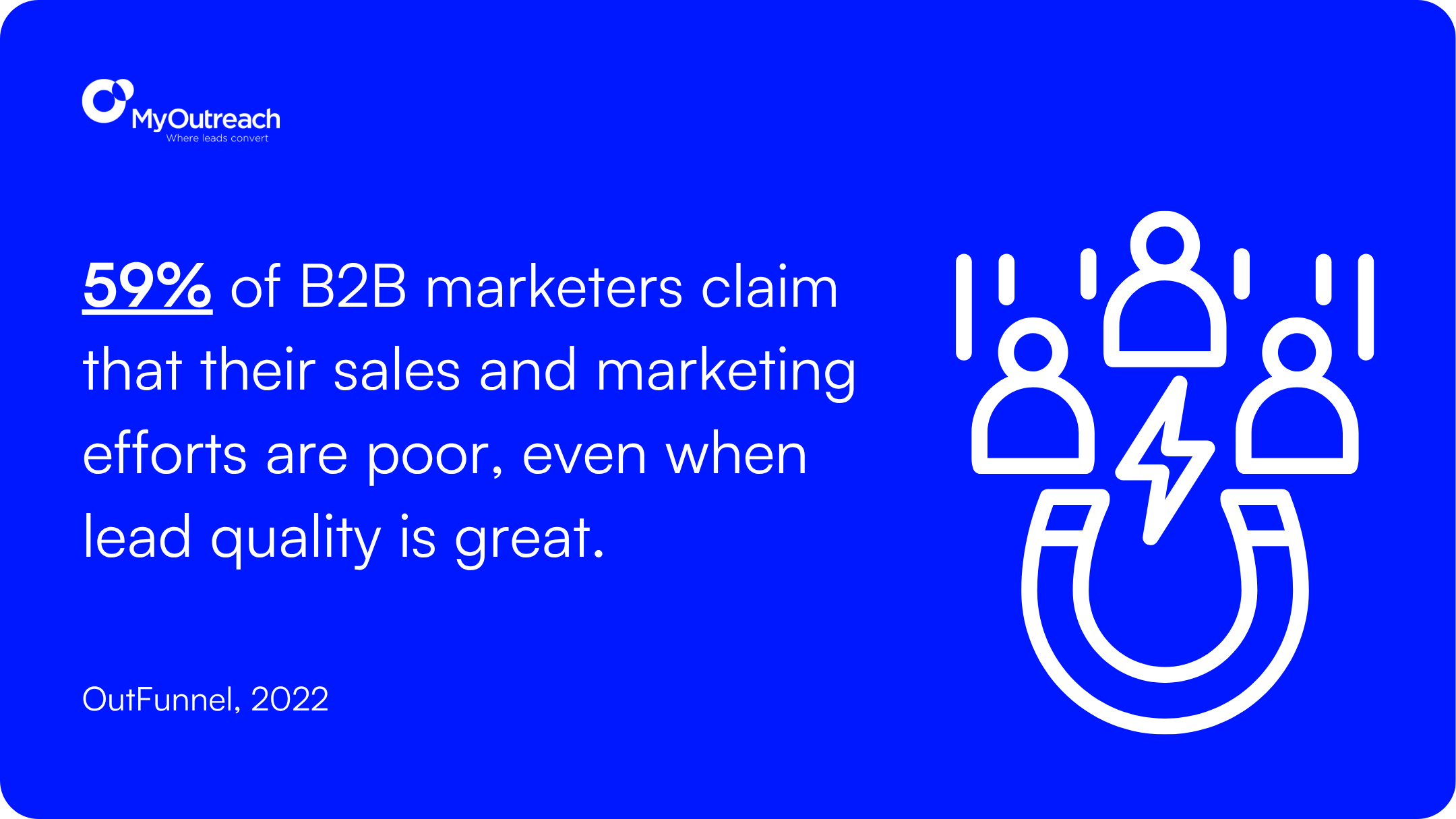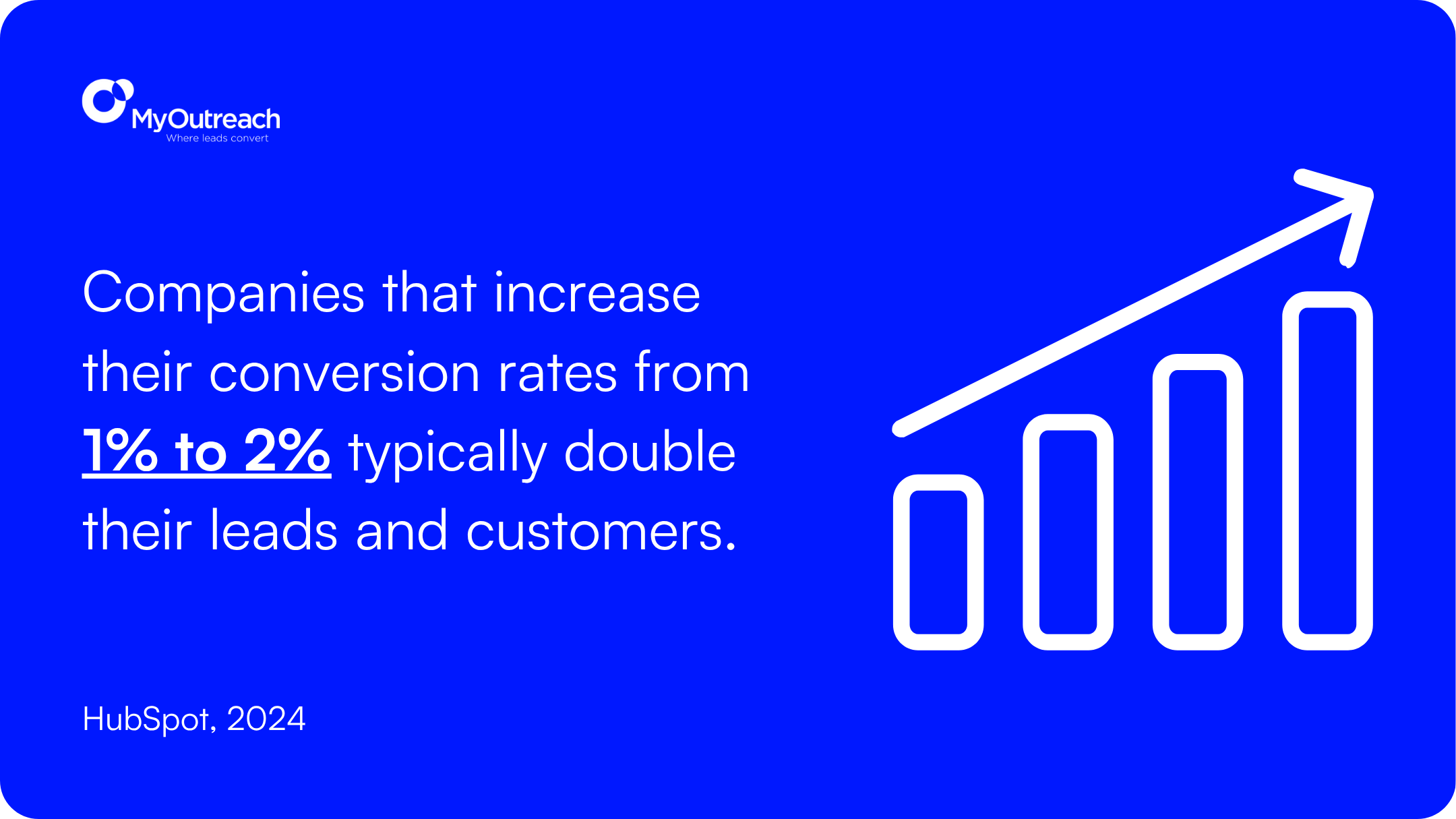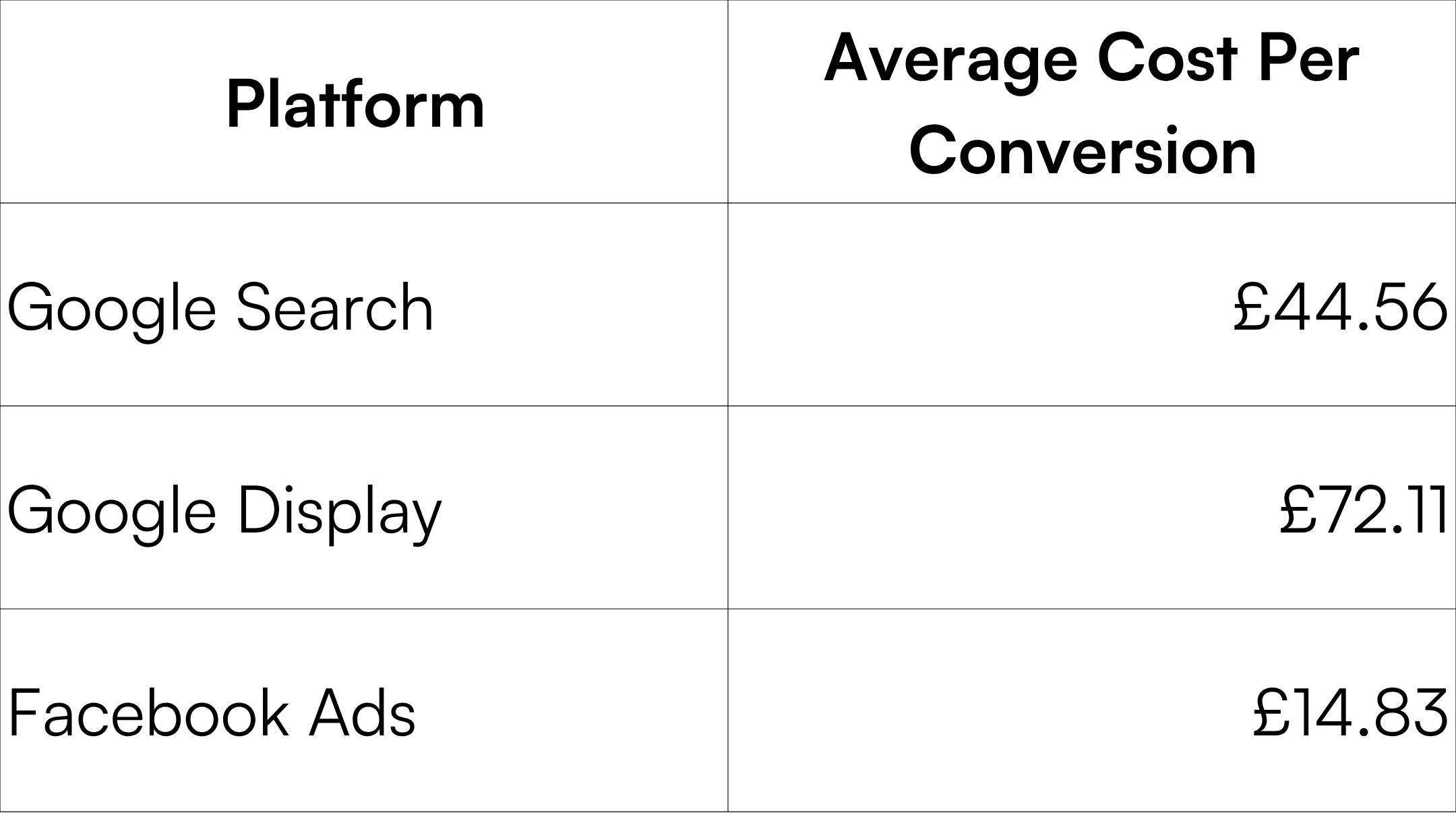Around 59% of B2B marketers claim that their sales and marketing efforts are poor, even when lead quality is great.
This disconnect usually comes from one thing: no one is tracking the right conversion rates. When you aren’t tracking conversion rates properly, leads fail to convert, pipeline stalls and your months of hard work waste your time, money, and effort - making it harder to generate leads that convert.
In this blog post, we’re going to discuss the most important B2B lead conversion rates to track across your funnel, so you can better align sales and turn leads into revenue.
Lead Conversion Rate: Turning Interest Into Leads That Convert
To measure the success of your leads, you need to track the right metric. Lead Conversion Rate (LCR) stands out as a key indicator of the effectiveness of sales and marketing efforts. This metric reveals how well you turn prospects into valuable business outcomes.
So, What is Lead Conversion Rate?
LCR measures how effectively your website turns visitors into leads. A lead is someone that takes meaningful action, like filling out a form or requiring a demo. This metric helps you understand how well your site captures interest and drives engagement.
Why does Lead Conversion Rate Matter?
We’ve explained what it is, but you still might be reading and thinking, “But wait, why does LCR matter to me?”.
Here’s one reason: Companies that increase their conversion rates from 1% to 2% typically double their leads and customers.
Let’s break down what LCR helps you with:
- Learn about your marketing spend’s ROI.
- Enables data-driven decisions across Sales and Marketing teams.
- Identify issues in your marketing and sales processes when rates drop.
- Create realistic customer acquisition budgets based on your past results.
- Compare results across marketing channels to optimise and allocate resources.
- Match your performance with industry standards to enhance your competitiveness.
This tracking allows you to review the effectiveness of your lead-nurturing strategies and identify areas for improvement. B2B tech and SaaS companies also need to optimise lead conversion to accelerate revenue growth.
Reality is simple: You can generate thousands of leads, but unless they convert, they create zero business value.

How to Calculate Lead Conversion Rate
LCR is simple to calculate, but what you measure can vary depending on the stage of the funnel.
The basic formula is:
LCR = (Converted Leads ÷ Total Leads) × 100
Example: If you generate 500 leads and 50 become customers:
→ (50 ÷ 500) × 100 = 10%
For TOFU conversions (like website visitors to leads), the formula is adjusted slightly:
LCR = (Leads ÷ Website Visitors) × 100
Example: If 15 people fill out a form out of 200 website visitors:
→ (15 ÷ 200) × 100 = 7.5%
Most CRM tools, such as Salesforce, make it easy to track progress with real-time dashboards that show converted leads and win rates.
Lead-to-Sale Conversion Rate: Measuring Leads That Convert Into Customers
Your sales process health becomes clear when you track how many leads convert to paying customers.
Lead-to-Sale Conversion Rate shows how effectively your funnel turns interest into revenue.
This metric reflects how well your sales team qualifies, nurtures, and closes leads. It’s one of the most important indicators of:
- Revenue growth.
- Sales performance.
- Lead Quality.
Lead-to-Sale Conversion Rate Explained
This specific rate focuses on completed sales transactions that drive revenue, unlike other conversion metrics that track engagement points, such as form submissions or email sign-ups.
Tracking this metric provides insight into the health of your sales funnel, showing where leads successfully convert into sales versus where prospects might drop off. Instead of just counting leads, it reveals how effectively your sales and marketing efforts are driving actual business outcomes.
Why Lead-to-Sale Conversion Rate is Important
Your lead-to-sale conversion rate helps streamline processes in several ways:
- Clear sales funnel visibility: Your team’s effectiveness is shown throughout the entire sales process.
- ROI understanding: Marketing spend connects directly with revenue, helping you see your ROI.
- Evidence-based decision making: Sales and Marketing teams can make smarter choices based on conversion patterns.
- Resource allocation: You can allocate your budget toward the most profitable activities by identifying which channels convert the best.
- Benchmarking opportunities: You can compare performance against industry standards and past results through regular tracking.
The quality of your leads becomes apparent through this metric, not just the number of contacts that you collect. Your conversion percentages help you figure out how many leads need to hit your customer acquisition targets.
This rate helps you focus on what counts, and that's: getting better leads instead of just more leads.
How to Calculate Lead-to-Sale Conversion Rate
The formula is simple:
Lead-to-Sale Conversion Rate = (Converted Leads ÷ Total Leads) × 100%
Example: If you convert 15 out of 500 leads:
→ (15 ÷ 500) × 100 = 3%
Tracking this metric on a weekly or monthly basis helps you identify trends early and adjust your pipeline before any issues arise.
Higher conversion rates often result from better-qualified leads, not simply having more of them. Focusing on lead quality improves revenue results.
Tools like Salesforce make tracking easy with built-in dashboards that automatically calculate this for you.
Remember: what counts as “good” varies by industry, product, and pricing model. Always compare your historical data and industry benchmarks.

What it All Means
If there is one clear takeaway from the relationship between Lead Conversion Rate and Lead-to-Sale Conversion Rate, it’s this: lead quality matters more than volume.
Too often, marketers focus on growing a long list of contacts, assuming more leads means better results. But if those leads aren’t qualified, you’ll end up scratching your head and wondering where all that time and budget went.
A better approach would be building a strong lead qualification process that filters buyers with real intent.
That’s where Content Syndication comes in. You can deliver your best-performing content to audiences already showing intent, based on their behavioural signals, such as search activity, engagement, and firmographic data.
📖 Useful read: What is Content Syndication and How Does it Work?
Solutions like MyOutreach’s Content Syndication could be your go-to for improving both lead conversion rates and lead-to-sale conversion rates, by starting with leads who are more likely to convert. This approach is faster and more cost-effective than building a lead engine from the ground up.
More Conversion Rate Metrics that Drive Revenue
Do you want a deeper analysis of your conversion performance? We’ve compiled a list of other conversion metrics worth tracking. Let’s break them down.
Lead-to-Opportunity Conversion Rate
Lead-to-Opportunity measures the percentage of leads that progress into qualified sales opportunities, providing you with early visibility into your pipeline health and sales process efficiency.
This metric focuses on MOFU, before the final sale. It also reveals how your team qualifies leads based on interest, fit and intent. Most CRMs (like Salesforce) track this movement as leads pass through stages (e.g. unqualified, working, nurturing) before entering the sales pipeline.
Why it matters? Because high-performing teams use this metric to:
- Build strong pipelines by focusing on quality leads.
- Improve forecasting accuracy through early conversion signals
- Save time by disqualifying unqualified prospects early.
- Identify funnel gaps and improve nurture sequences.
- Align teams with shared qualification criteria.
Most companies average a Lead-to Opportunity conversion rate of around 12%, while an exceptional one would be at 25%.
The formula for Lead-to-Opportunity rate is:
Lead-to-Opportunity Rate = (Qualified Opportunities ÷ Total Leads) × 100
Example: If you turn 80 out of 200 leads into pipeline opportunities:
→ (80 ÷ 200) × 100 = 40%
To improve this rate, try to:
- Set clear criteria for what a qualified opportunity is.
- Standardise lead scoring and intent signals.
- Revisit qualification rules regularly to avoid funnel leaks.
Cost Per Conversion
CPC measures how much you spend on average to get one successful conversion, whether a sale, lead or sign-up. It links marketing spending directly to results, helping you understand ROI and optimise budgets.
Why it matters? Here are some of the reasons:
- Shows which channels deliver the best value.
- Helps optimise marketing spending.
- Reveals potential issues in user experience.
- Guides you through realistic goal setting.
How to calculate:
Cost Per Conversion = Total Advertising Costs ÷ Number of Conversions
Industry benchmarks:

Costs vary by industry and product complexity: higher costs often reflect longer sales cycles.
Time to Conversion
This metric tracks how long a lead takes to convert after the first contact, revealing funnel efficiency.
Why it matters:
- Faster responses significantly increase conversion chances (21x more likely within 5 minutes).
- Longer delays dramatically reduce conversion rates (contacting a lead within 30 minutes drops chances of qualifying them).
- Improves customer experience and sales velocity.
How to calculate:
- Time to Conversion = Conversion Timestamp – First Interaction Timestamp
- Average Time = Total Conversion Time ÷ Number of Conversions
Tracking by channel, product, or price helps identify where you should improve speed.
📖 You might also like: Top 5 Techniques to Generate B2B Leads for SaaS Companies
Conclusion
We covered the essentials: LCR, Lead-to-Sale Rate, Lead-to-Opportunity Rate, CPC, and Time to Conversion. Tracking conversion metrics is a proven strategy for revenue growth. Each one tells you something different about your sales funnel, providing clarity on addressing issues, boosting ROI, and driving revenue growth.
Ready to Optimise Your Funnel with High-Intent Leads?
At MyOutreach we help B2B SaaS companies generate qualified leads that convert through various proven strategies.
By combining intent data, firmographics and advanced targeting, we make it easier for B2B marketers to hit conversion goals without wasting time or budget on low-quality leads.
Let’s talk about how we can help you hit your conversion goals and fill your pipeline with qualified leads.
FAQs
Q1. What’s the most effective way to track lead conversion?
To track lead conversion, divide the number of leads by the total number of visitors and then multiply the result by 100. If your website receives 500 visitors and 20 fill out a form, your lead rate is 4%.
Q2. How can businesses accurately measure lead conversion rates?
To measure conversion rates, calculate the ratio of leads to the total number of visitors. Divide the number of leads by the total number of site visitors and then multiply the result by 100%. This percentage reflects how effectively you’re converting visitors into potential customers.
Q3. What are the metrics for tracking conversion success besides LCR?
Besides LCR, important metrics include:
- Bounce rate.
- Funnel drop-off rate.
- Customer lifetime value (CLV).
- Revenue per visitor.
- Customer churn rate.
These metrics provide a clear view of your conversion funnel and customer retention efforts.

.png)

.png)
.png)
.png)






